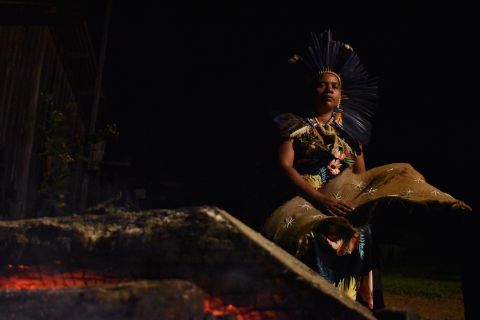Glicéria Tupinambá

Glicéria Tupinambá and Túlio Rosa, Tupinambá Ybaka (2023), video still © Túlio Rosa
Active leader, Indigenous women’s rights advocate, intercultural educator, intellectual, and artist Glicéria Tupinambá focuses on recovering Nhengaatu, her people’s language, and restoring the practice of crafting Tupinambá mantles— efforts that are intertwined with the struggle for sovereignty and autonomous sustainability of their land. The sacred cloaks worn by shamans, made from the feathers of the scarlet ibis, were brought to colonial European courts in the sixteenth century and some remain in museums today. Tupinambá restarted this tradition in 2006 after centuries of latency, in a sensitive process she calls ‘technical cosmos’, with the help of photographs, dreams, traditional knowledge of manufacturing fishing nets and twines, and the participation of the living and spiritual community of this territory—a land necessary for the mantles’ existence. On the cusp of restitution discussions, this process empowered her people. For O Quilombismo, she creates Tupinambá Ybaka, reclaiming the ancestral connection of her people to the stars. The works are accompanied by a letter to the audience.
In a residency at HKW in 2024 Glicéria will further her collaboration with other artists and curators, engaging with some of the missing parts to be found in European collections, of the mantle’s sacred ritual, and the wisdom emanating from its performance.
Works in the exhibition: Tupinambá Ybaka [The Tupinambá Sky] (2023), coconut tree bark, cotton thread. Courtesy of the artist; Fernanda Liberti in collaboration with Glicéria Tupinambá, Dancing with the Tupinambá: Mother Bird and Son, Glicéria and Eru, Serra do Padeiro, Bahia, Brazil; Bird View; Thousand in One; Abraço [Hug]; Majé [Female Shaman]; Poço deIemanjá [Iemanjá’s Well] (2021), photographic series. Courtesy of the artist